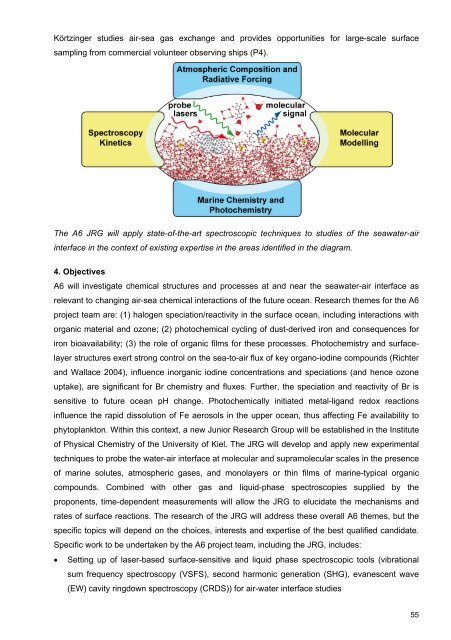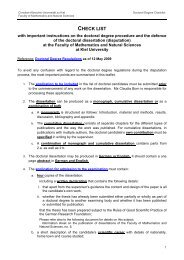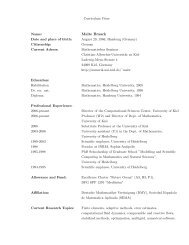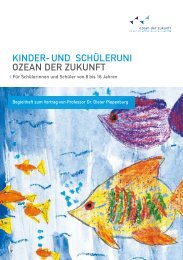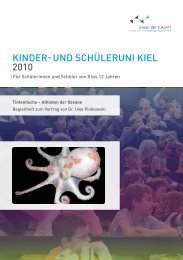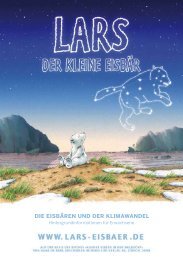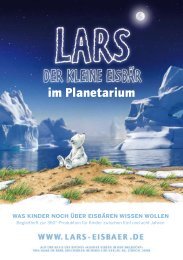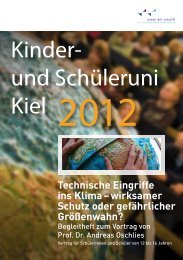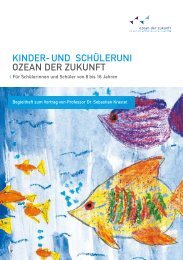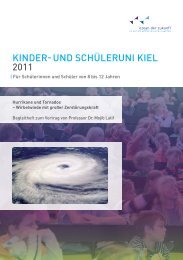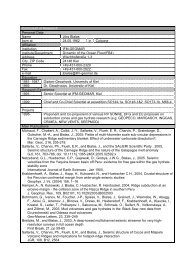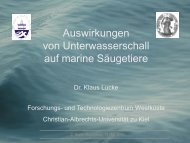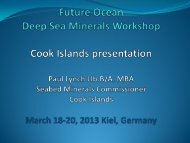Körtzinger studies air-sea gas exchange and provides opportunities for large-scale surfacesampling from commercial volunteer observing ships (P4).<strong>The</strong> A6 JRG will apply state-of-the-art spectroscopic techniques to studies of the seawater-airinterface in the context of existing expertise in the areas identified in the diagram.4. ObjectivesA6 will investigate chemical structures and processes at and near the seawater-air interface asrelevant to changing air-sea chemical interactions of the future ocean. Research themes for the A6project team are: (1) halogen speciation/reactivity in the surface ocean, including interactions withorganic material and ozone; (2) photochemical cycling of dust-derived iron and consequences foriron bioavailability; (3) the role of organic films for these processes. Photochemistry and surfacelayerstructures exert strong control on the sea-to-air flux of key organo-iodine compounds (Richterand Wallace 2004), influence inorganic iodine concentrations and speciations (and hence ozoneuptake), are significant for Br chemistry and fluxes. Further, the speciation and reactivity of Br issensitive to future ocean pH change. Photochemically initiated metal-ligand redox reactionsinfluence the rapid dissolution of Fe aerosols in the upper ocean, thus affecting Fe availability tophytoplankton. Within this context, a new Junior Research Group will be established in the Instituteof Physical Chemistry of the University of Kiel. <strong>The</strong> JRG will develop and apply new experimentaltechniques to probe the water-air interface at molecular and supramolecular scales in the presenceof marine solutes, atmospheric gases, and monolayers or thin films of marine-typical organiccompounds. Combined with other gas and liquid-phase spectroscopies supplied by theproponents, time-dependent measurements will allow the JRG to elucidate the mechanisms andrates of surface reactions. <strong>The</strong> research of the JRG will address these overall A6 themes, but thespecific topics will depend on the choices, interests and expertise of the best qualified candidate.Specific work to be undertaken by the A6 project team, including the JRG, includes:• Setting up of laser-based surface-sensitive and liquid phase spectroscopic tools (vibrationalsum frequency spectroscopy (VSFS), second harmonic generation (SHG), evanescent wave(EW) cavity ringdown spectroscopy (CRDS)) for air-water interface studies55
• Field and laboratory investigations into the effects of future forcing changes on speciation andthe reactivity of halogens and iron close to the sea surface (including consideration of pHchange, ozone-iodide reactions, redox and speciation changes, quantum yields, solvent (cage)effects)• Measurements of radical, dimethylsulfide, and ozone reaction kinetics at the liquid surface(including quantitative monitoring of gas and liquid phase products, using quasi steady-stateand time-resolved (laser) photolysis, VSFS, EW-CRDS, LIF)• Structural and photochemical studies at and in organic monolayers and thin organic films onwater (including phospholipid microlayers and release of volatile organic compounds)• <strong>The</strong>oretical studies of the processes outlined above by ab initio quantum chemistry andreactions of (catalytically active) metals in water clusters and supplementary experimentsA6 will provide basic understanding relevant to A4 and A7 and will benefit from cross-fertilization ofexperimental and theoretical approaches with A5. Acidification effects research parallels work inA1, and iron chemistry has relevance for B2. <strong>The</strong>oretical work will use P1 and spectroscopicmethods arising from A6 can be integrated in P4.5. ReferencesAarts IMP, et al. (2005) Quasi-Ice Monolayer on Atomically Smooth Amorphous SiO 2 at RoomTemperature Observed with a High-Finesse Optical Resonator. Phys Rev. Lett. 95, 166104.Bianco R, Hynes JT (2006) Heterogeneous Reactions Important in Atmospheric Ozone Depletion:A <strong>The</strong>oretical Perspective. Acc. Chem. Res. 39, 159-165.Chang W, Heikes BG, Lee M (2004) Ozone deposition to the sea surface: chemical enhancementand wind speed dependence. Atmos. Environ. 38, 1053-1059.Lelieveld J, van Aardenne J, Fischer H, de Reus M, Williams J, Winkler P (2004) Increasing Ozoneover the Atlantic <strong>Ocean</strong>. Science 304, 1483-1487.Mucha M, Frigato T, Levering LM, Allen HC, Tobias DJ, Dang LX, Jungwirth P (2005) UnifiedMolecular Picture of the Surfaces of Aqueous Acid, Base, and Salt Solutions. J. Phys. Chem.B, 109, 7617-7623.von Glasow R, Crutzen PJ (2003) Tropospheric Halogen Chemistry. Chapter 2 in vol. 4 of Treatiseon Geochemistry edited by KK Turekian and HD Holland, p. 21 - 64.Richmond GL (2001) Structure and Bonding of Molecules at Aqueous Surfaces. Annu. Rev. Phys.Chem. 52, 357-389.Richter U, Wallace DWR (2004) Production of methyl iodide in the tropical Atlantic <strong>Ocean</strong>.Geophys. Res. Lett. 31, L23S03.Shen YR (1989) Surface properties probed by second-harmonic and sum-frequency generation.Nature 337, 519-525.Schulz F, Hartke B (2005) A New Proposal for the Reason of Magic Numbers in Alkali CationMicrohydration Clusters. <strong>The</strong>or. Chem. Acc. 114, 357-380.Thomas JL, et al. (2006) Gas-Phase Molecular Halogen Formation from NaCl and NaBr Aerosols:When Are Interface Reactions Important? J. Phys. Chem. A 110, 1859-1867.56
- Page 7 and 8:
Contents1 General Information about
- Page 9 and 10:
1 General Information about the Clu
- Page 11 and 12: 1.2 Research Program1.2.1 Summary/Z
- Page 13 and 14: 1.2.2.2 ObjectivesThe Future Ocean
- Page 15 and 16: will address the emerging new resea
- Page 17 and 18: Topics Objectives DisciplinesA1 Exa
- Page 19 and 20: development of these new initiative
- Page 21 and 22: Project Objective IndustryPartnersO
- Page 23 and 24: Continued excellence in the field o
- Page 25 and 26: The establishment of several new po
- Page 27 and 28: 1.4.1 Integrated School of Ocean Sc
- Page 29 and 30: ensure that emerging innovations wi
- Page 31 and 32: Institute / DisciplineAcademic Leve
- Page 33 and 34: their orientation according to the
- Page 35 and 36: 1.7.2 Structural Evolution and Qual
- Page 37 and 38: 30- Notes -
- Page 39 and 40: organisms to elevated CO 2 and decr
- Page 41 and 42: ist wahrscheinlich stärker als wä
- Page 43 and 44: out by the proponents and will esta
- Page 45 and 46: Rückkopplungsschleife weitere Erw
- Page 47 and 48: enthic biota of gas release or the
- Page 49 and 50: Synthese, aufbauend auf einer Kombi
- Page 51 and 52: (4) a determination of the impact o
- Page 53 and 54: Einflüsse. Um deren Auswirkungen b
- Page 55 and 56: on longer time scales. The latter t
- Page 57 and 58: werden kann. Allerdings sind die ch
- Page 59 and 60: the expertise which already exists
- Page 61: 2. State-of-the-artThe changing com
- Page 65 and 66: Erwärmung der Ozeane kann zur Frei
- Page 67 and 68: Valuing the Ocean: Research focus a
- Page 69 and 70: submarine earthquakes, slumps and s
- Page 71 and 72: Fischerei ist eine der wichtigsten
- Page 73 and 74: ecosystems. In particular, the foll
- Page 75 and 76: Hochdurchsatztechnologien die Evolu
- Page 77 and 78: microbial diversity on their barrie
- Page 79 and 80: transient three-dimensional fluid f
- Page 81 and 82: modeling, which describe chemical a
- Page 83 and 84: Erdbeben, submarine Hangrutschungen
- Page 85 and 86: Simons 2003) to investigate shallow
- Page 87 and 88: damit zusammenhängender Meeresspie
- Page 89 and 90: B5(1) Sea-Level Rise and Physical-M
- Page 91 and 92: Pickrill RA, Todd BJ (2003) The mul
- Page 93 and 94: Onate E, Piazzese J (2005) Decision
- Page 95 and 96: echtlichen und ökonomischen Rahmen
- Page 97 and 98: marine resources, such as energy ex
- Page 99 and 100: 92- Notes -
- Page 101 and 102: 2. State-of-the-artThe variety of n
- Page 103 and 104: and will benefit from expertise in
- Page 105 and 106: Die Plattform 2 stellt die analytis
- Page 107 and 108: 4. New Cluster TechnologiesIn order
- Page 109 and 110: (iv) Proteomanalysetechniken und (v
- Page 111 and 112: 4. New Cluster TechnologiesA specia
- Page 113 and 114:
Illustration of existing/emerging a
- Page 115 and 116:
physical parameters (e.g. lowered a
- Page 117 and 118:
etabliert, das insbesondere auf wis
- Page 119 and 120:
2.4.3.2 Central Funds for Transfer
- Page 121 and 122:
International School of Ocean Scien
- Page 123 and 124:
Description Year of purchase Amount
- Page 125 and 126:
3.2 Auxiliary Support3.2.1 Total Fu
- Page 127 and 128:
120- Notes -
- Page 129 and 130:
Suess E, Torres ME, Bohrmann G, Col
- Page 131 and 132:
Schreiber, StefanVisbeck, MartinSri
- Page 133 and 134:
4.3 Third-Party FundingNo. FundingB
- Page 135 and 136:
Leibniz Institute of Marine Science
- Page 137 and 138:
These JRG’s will augment the expe
- Page 139 and 140:
The Cluster is embedded in the “K
- Page 141 and 142:
A14- Notes -
- Page 143 and 144:
4.6 Curricula Vitae and Lists of Pu
- Page 145 and 146:
Curriculum of ResearchPersonal Data
- Page 147 and 148:
Curriculum of ResearchPersonal Data
- Page 149 and 150:
Curriculum of ResearchPersonal Data
- Page 151 and 152:
Curriculum of ResearchPersonal Data
- Page 153 and 154:
Curriculum of ResearchPersonal Data
- Page 155 and 156:
Curriculum of ResearchPersonal Data
- Page 157 and 158:
Curriculum of ResearchPersonal Data
- Page 159 and 160:
Curriculum of ResearchPersonal Data
- Page 161 and 162:
Curriculum of ResearchPersonal Data
- Page 163 and 164:
Curriculum of ResearchPersonal Data
- Page 165 and 166:
Curriculum of ResearchPersonal Data
- Page 167 and 168:
Curriculum of ResearchPersonal Data
- Page 169 and 170:
Curriculum of ResearchPersonal Data
- Page 171 and 172:
Curriculum of ResearchPersonal Data
- Page 173 and 174:
Curriculum of ResearchPersonal Data
- Page 175 and 176:
Curriculum of ResearchPersonal Data
- Page 177 and 178:
Curriculum of ResearchPersonal Data
- Page 179 and 180:
Curriculum of ResearchPersonal Data
- Page 181 and 182:
Curriculum of ResearchPersonal Data
- Page 183 and 184:
Curriculum of ResearchPersonal Data
- Page 185 and 186:
Curriculum of ResearchPersonal Data
- Page 187 and 188:
Curriculum of ResearchPersonal Data
- Page 189 and 190:
Curriculum of ResearchPersonal Data
- Page 191 and 192:
Curriculum of ResearchPersonal Data
- Page 193 and 194:
Curriculum of ResearchPersonal Data
- Page 195 and 196:
Curriculum of ResearchPersonal Data
- Page 197 and 198:
Curriculum of ResearchPersonal Data
- Page 199 and 200:
Curriculum of ResearchPersonal Data
- Page 201 and 202:
Curriculum of ResearchPersonal Data
- Page 203 and 204:
Curriculum of ResearchPersonal Data
- Page 205 and 206:
Curriculum of ResearchPersonal Data
- Page 207 and 208:
Curriculum of ResearchPersonal Data
- Page 209 and 210:
A82- Notes -
- Page 211 and 212:
DEKLIMGerman Climate Research Progr
- Page 213 and 214:
ITQ’sISAISOSJRGKCMSKitzLALIFLIMSL
- Page 215 and 216:
WTOWTSHXAFSXRDZMBWorld Trade Organi
- Page 218:
Prof. Dr. Boris Culik • Maritimes
- Page 230:
GMT-Geschäf*sstelleWe"*w{eltJ"*n $
- Page 236:
f,rylheonRaytheon Anschütz GmbHPos


